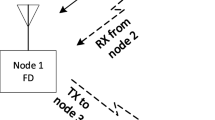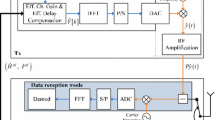Abstract
The main obstacle to full-duplex radios is self-interference (SI). To overcome SI, researchers have proposed several analog and digital domain self-interference cancellation (SIC) techniques. Digital cancellation has the following limitations: (1) It is only possible if the SI is sufficiently removed in the analog domain to fall within the dynamic range of an analog-to-digital converter (ADC). (2) It cannot mitigate the transmitter noise. Thus, analog cancellation plays an important role in a SIC scenario. This chapter provides an overview of current research activities on the analog cancellation scheme. Analog cancellation can be categorized into two classes—passive and active. In the passive analog cancellation, an RF component suppresses the SI. This can be implemented using a circulator or antenna separation. Leakages are cancelled by the active analog cancellation, which is based on a channel estimation of residual SI channel. The leakage from the passive cancellation can be matched by a signal generated from a tunable circuit or an auxiliary transmit chain. A key issue then in active analog cancellation is designing a circuit and optimization algorithm.
Access this chapter
Tax calculation will be finalised at checkout
Purchases are for personal use only
Similar content being viewed by others
References
J. A. Nelder and R. Mead, “A simplex method for function minimization,” The Computer Journal, vol. 7, no. 4, pp. 308–313, 1965.
C. Cox, Analog optical links. Cambridge, U.K: Cambridge Univ.Press, 2004.
J. I. Choi, M. Jain, K. Srinivasan, P. Levis, and S. Katti, “Achieving single channel, full duplex wireless communication,” in ACM Mobicom, Chicago, Illinois, USA, September 2010, pp. 20–24.
E. Aryafar, M. A. Khojastepour, K. Sundaresan, S. Rangarajan, and M. Chiang, “MIDU: enabling mimo full duplex,” in ACM Mobicom, Istanbul, Turkey, August 2012, pp. 22–26.
T. Oh, Y. Lim, C. Chae, and Y. Lee, “Dual-polarization slot antenna with high cross-polarization discrimination for indoor small-cell mimo systems,” IEEE Antennas and Wireless Propagation Letters, vol. 14, pp. 374–377, 2015.
M. Chung, M. S. Sim, J. Kim, D. K. Kim, and C. Chae, “Prototyping real-time full duplex radios,” IEEE Communications Magazine, vol. 53, no. 9, pp. 56–63, 2015.
J. G. McMichael and K. E. Kolodziej, “Optimal tuning of analog self-interference cancellers for full-duplex wireless communication,” in Allerton conference on communication, control and computing, Monticello, IL, USA, October 2012, 2012, pp. 1–5.
L. Anttila, D. Korpi, V. Syrjälä, and M. Valkama, “Cancellation of power amplifier induced nonlinear self-interference in full-duplex transceivers,” in Asilomar conference on signals, systems and computers, Pacific Grove, CA, November 2013, 2013, pp. 3–6.
A. Sahai, G. Patel, C. Dick, and A. Sabharwal, “On the impact of phase noise on active cancelation in wireless full-duplex,” IEEE Transactions on Vehicular Technology, vol. 62, no. 9, pp. 4494–4510, 2013.
C. Cox and E. Ackerman, “Demonstration of a single-aperture, full-duplex communication system,” in Radio and wireless symposium (RWS), vol. 2013, Austin, TX, USA, January 2013, pp. 20–23.
C. Cox and E. Ackerman, “Tiprx: a transmit-isolating photonic receiver,” Journal of Lightwave Technology, vol. 32, no. 20, pp. 3630–3636, 2014.
J. Chang and P. R. Prucnal, “A novel analog photonic method for broadband multipath interference cancellation,” IEEE Microwave and Wireless Components Letters, vol. 23, no. 7, pp. 377–379, 2013.
D. Bharadia, E. McMilin, and S. Katti, “Full duplex radios,” pp. 12–16, August 2013.
D. Bharadia and S. Katti, “Full duplex mimo radios,” in USENIX symposium on networked systems design and implementation, Seattle WA, April 2014, 2014, pp. 2–4.
J. Kim, M. S. Sim, M. K. Chung, D. K. Kim, and C. Chae, Signal processing for 5G: algorithms and implementations. New York, NY, USA, p 539-560: Wiley, 2016.
M. P. Chang, C. Lee, B. Wu, and P. R. Prucnal, “Adaptive optical self-interference cancellation using a semiconductor optical amplifier,” IEEE Photonics Technology Letters, vol. 27, no. 9, pp. 1018–1021, 2016.
W. Zhou, P. Xiang, Z. Niu, M. Wang, and S. Pan, “Wideband optical multipath interference cancellation based on a dispersive element,” IEEE Photonics Technology Letters, vol. 28, no. 8, pp. 849–851, 2016.
D. Liu, Y. Shen, S. Shao, Y. Tang, and Y. Gong, “On the analog self-interference cancellation for full-duplex communications with imperfect channel state information,” IEEE Access, vol. 5, pp. 9277–9290, 2017.
M. P. Chang, E. C. Blow, J. J. Sun, M. Z. Lu, and P. R. Prucnal, “Integrated microwave photonic circuit for self-interference cancellation,” IEEE Transactions on Microwave Theory and Techniques, vol. 65, no. 11, pp. 4493–4501, 2017.
E. Everett, A. Sahai, and A. Sabharwal, “Passive self-interference suppression for full-duplex infrastructure nodes,” IEEE Transactions on Wireless Communications, vol. 13, no. 2, pp. 680–694, 2014.
Author information
Authors and Affiliations
Corresponding author
Editor information
Editors and Affiliations
Rights and permissions
Copyright information
© 2020 Springer Nature Singapore Pte Ltd.
About this chapter
Cite this chapter
Kwak, J.W., Sim, M.S., Kang, IW., Park, J., Chae, CB. (2020). Antenna/RF Design and Analog Self-Interference Cancellation. In: Alves, H., Riihonen, T., Suraweera, H. (eds) Full-Duplex Communications for Future Wireless Networks. Springer, Singapore. https://doi.org/10.1007/978-981-15-2969-6_2
Download citation
DOI: https://doi.org/10.1007/978-981-15-2969-6_2
Published:
Publisher Name: Springer, Singapore
Print ISBN: 978-981-15-2968-9
Online ISBN: 978-981-15-2969-6
eBook Packages: Computer ScienceComputer Science (R0)




